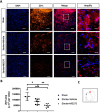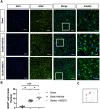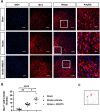HDAC1 is Involved in Neuroinflammation and Blood-Brain Barrier Damage in Stroke Pathogenesis
- PMID: 37745794
- PMCID: PMC10516226
- DOI: 10.2147/JIR.S416239
HDAC1 is Involved in Neuroinflammation and Blood-Brain Barrier Damage in Stroke Pathogenesis
Abstract
Background: Stroke is a common cause of disability and mortality worldwide; however, effective therapy remains limited. In stroke pathogenesis, ischemia/reperfusion injury triggers gliosis and neuroinflammation that further activates matrix metalloproteinases (MMPs), thereby damaging the blood-brain barrier (BBB). Increased BBB permeability promotes macrophage infiltration and brain edema, thereby worsening behavioral outcomes and prognosis. Histone deacetylase 1 (HDAC1) is a repressor of epigenomic gene transcription and participates in DNA damage and cell cycle regulation. Although HDAC1 is deregulated after stroke and is involved in neuronal loss and DNA repair, its role in neuroinflammation and BBB damage remains unknown.
Methods: The rats with cerebral ischemia were evaluated in behavioral outcomes, levels of inflammation in gliosis and cytokines, and BBB damage by using an endothelin-1-induced rat model with cerebral ischemia/reperfusion injury.
Results: The results revealed that HDAC1 dysfunction could promote BBB damage through the destruction of tight junction proteins, such as ZO-1 and occludin, after stroke in rats. HDAC1 inhibition also increased the levels of astrocyte and microglial gliosis, tumor necrosis factor-alpha, interleukin-1 beta, lactate dehydrogenase, and reactive oxygen species, further triggering MMP-2 and MMP-9 activity. Moreover, modified neurological severity scores for the cylinder test revealed that HDAC1 inhibition deteriorated behavioral outcomes in rats with cerebral ischemia.
Discussion: HDAC1 plays a crucial role in ischemia/reperfusion-induced neuroinflammation and BBB damage, thus indicating its potential as a therapeutic target.
Keywords: HDAC1; IL-1β; ROS; TNF-α; blood-brain barrier; cylinder test; mNSS; stroke.
© 2023 Wang et al.
Conflict of interest statement
The authors declare there is no conflict of interest in this study.
Figures







Similar articles
-
HDAC1 deregulation promotes neuronal loss and deficit of motor function in stroke pathogenesis.Sci Rep. 2021 Aug 11;11(1):16354. doi: 10.1038/s41598-021-95837-3. Sci Rep. 2021. PMID: 34381129 Free PMC article.
-
Restoration of HDAC1 Enzymatic Activity after Stroke Protects Neurons from Ischemia/Reperfusion Damage and Attenuates Behavioral Deficits in Rats.Int J Mol Sci. 2021 Sep 30;22(19):10654. doi: 10.3390/ijms221910654. Int J Mol Sci. 2021. PMID: 34638996 Free PMC article.
-
Ligustrazine reduces blood-brain barrier permeability in a rat model of focal cerebral ischemia and reperfusion.Exp Ther Med. 2015 May;9(5):1757-1762. doi: 10.3892/etm.2015.2365. Epub 2015 Mar 16. Exp Ther Med. 2015. PMID: 26136889 Free PMC article.
-
Ameliorating effects of traditional Chinese medicine preparation, Chinese materia medica and active compounds on ischemia/reperfusion-induced cerebral microcirculatory disturbances and neuron damage.Acta Pharm Sin B. 2015 Jan;5(1):8-24. doi: 10.1016/j.apsb.2014.11.002. Epub 2015 Jan 24. Acta Pharm Sin B. 2015. PMID: 26579420 Free PMC article. Review.
-
Interaction of free radicals, matrix metalloproteinases and caveolin-1 impacts blood-brain barrier permeability.Front Biosci (Schol Ed). 2011 Jun 1;3(4):1216-31. doi: 10.2741/222. Front Biosci (Schol Ed). 2011. PMID: 21622267 Review.
Cited by
-
Protective Effects of Rat Bone Marrow Mesenchymal Stem Cells-Derived Fusogenic Plasma Membrane Vesicles Containing VSVG Protein Mediated Mitochondrial Transfer on Myocardial Injury In Vitro.FASEB Bioadv. 2025 Apr 15;7(5):e70010. doi: 10.1096/fba.2024-00235. eCollection 2025 May. FASEB Bioadv. 2025. PMID: 40330432 Free PMC article.
-
Identification and Characterization of a Translational Mouse Model for Blood-Brain Barrier Leakage in Cerebral Small Vessel Disease.Int J Mol Sci. 2025 Jul 12;26(14):6706. doi: 10.3390/ijms26146706. Int J Mol Sci. 2025. PMID: 40724955 Free PMC article.
-
Histone Deacetylase 2 in Alzheimer's Disease: A Comprehensive Molecular Blueprint for Therapeutic Targeting.Mol Neurobiol. 2025 Aug 8. doi: 10.1007/s12035-025-05264-y. Online ahead of print. Mol Neurobiol. 2025. PMID: 40781362 Review.
-
Potential therapeutic targets for ischemic stroke in pre-clinical studies: Epigenetic-modifying enzymes DNMT/TET and HAT/HDAC.Front Pharmacol. 2025 Apr 28;16:1571276. doi: 10.3389/fphar.2025.1571276. eCollection 2025. Front Pharmacol. 2025. PMID: 40356977 Free PMC article. Review.
-
Role of autophagy in neurotoxic protein's clearance following post-ischemic stroke: where we are and what we know?Mol Brain. 2025 Jul 8;18(1):60. doi: 10.1186/s13041-025-01201-1. Mol Brain. 2025. PMID: 40629391 Free PMC article. Review.
References
LinkOut - more resources
Full Text Sources
Miscellaneous

